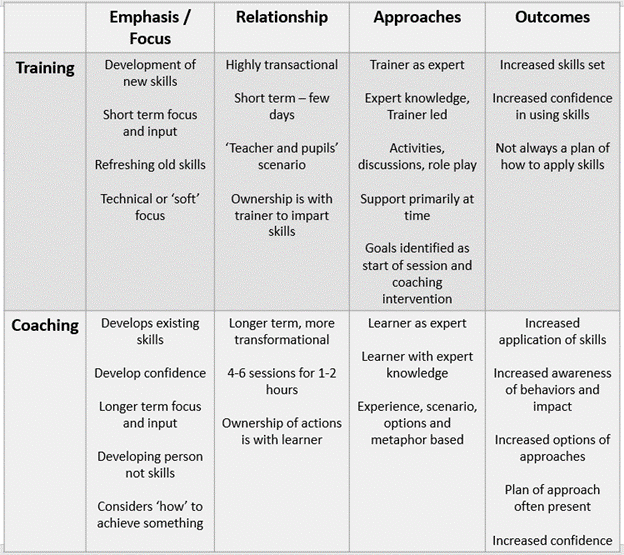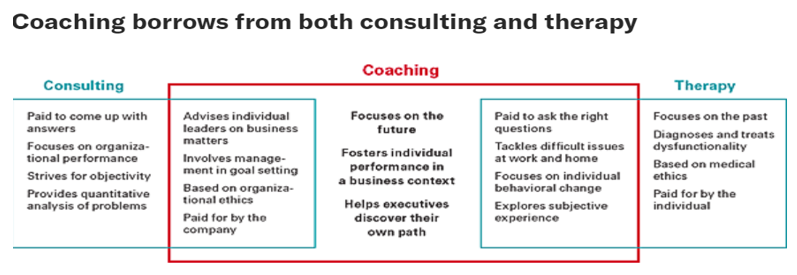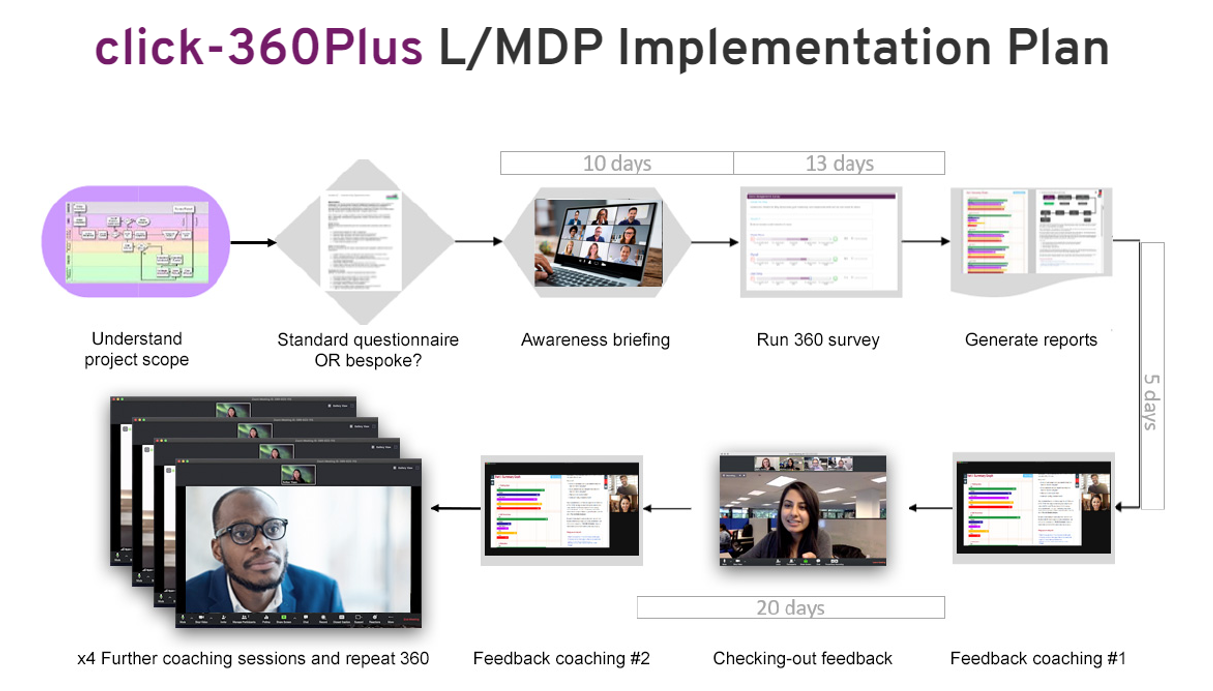Every year, millions of pounds, dollars and euros are spent on leadership and/or management development programs (L/MDPs). Our research team spent weeks looking for published evidence on their effectiveness. They really struggled. What they found was plenty of evidence that suggested a poor return on expectation, let alone return on investment.
At the same time, our research team also looked for evidence of the effectiveness of executive coaching. They found a considerable amount, much of it recent.
This blog summarizes their findings. It concludes with our recommendations for developing leaders and managers in a world where face-to-face contact and classroom-based training is becoming much more difficult.
Coaching and classroom-based training are two of the most used development methodologies by many global organizations to develop, create or improve a(n) (existing) set of knowledge, skills and behavior that an employer or an employee needs to own. The terms "Coaching" and "Training" can be frequently used interchangeably and lead to confusion. but if a client is well-aware of the published evidence and differences that exist around each method, they will make the right call by choosing the most beneficial approach for their needs.
In this blog post, you will find the key answers to the question “Why is coaching more effective than classroom-based training?”, together with all the evidence-based information to understand what works better for you according to your needs, which one can help reduce costs, and most importantly, what is the best option to see remarkable results?
Since the COVID-19 crisis started, senior managers and company executives have had to adapt to a new way of living and working. Most importantly, they have tried to maintain a high-business performance for their customers and employees whilst minimizing the global damage produced by the coronavirus. Therefore, keeping your leaders, managers and future leaders trained at the highest standard to still deliver results for your organization has never been more important. Hard to do when you factor in just how busy they are…working from home (often available not only during the day but also at unsociable hours during the night) and often having to juggle the multiple demands that this brings – home schooling, caring for relatives, housework & etc. Things are changing dramatically at a higher speed than ever before from a global perspective, and with the current situation seemingly going on for some time to come (and hybrid working set to be a common pattern for many staff), everyone needs to understand how vital it is to choose the developmental method that works best to maximize your potential and fits best with the working style of your people.
Without any doubt, many organizations believe that coaching and L/MDPs represent valuable tools when it comes to people's development. Try as we might, we found it surprisingly difficult to find quantitative evidence on the impact of classroom-based training…much less of it exists than the amount we found on coaching. Is this sending a message in and of itself? 30 years or so ago I remember being shown some results from a study done by the Food and Drugs Administration in the USA (FDA) that reported less than 50% of what was taught was remembered within just 6 weeks of the training, while in 3 months only 7% was being used. However, we have been unable to find that study in our research.
Meanwhile, there is a wealth of published evidence on the impact of coaching. We have tried to summarize the evidence in this blog and have provided numerous links to some of our sources. Here’s something we found on coaching:
According to the 'Institute of Coaching', more than 80% of people who were part of a coaching program and received a coaching feedback/report were positively stimulated in their self-confidence. As well, over 70% saw an improvement in their relationships, work performance and communication skills. As positive results go a long way to demonstrating the difference between a development approach that is worth the money or not, 86% of these companies mentioned that they "recouped their investment on coaching and more." (Source: Institute of Coaching2)
Why is coaching more effective than classroom-based training?

(Source: Boysen, 20186 ; Ryan, 20193 )
On the one hand, we could point out that the main difference between coaching and training is that coaching is a multi-dimensional, development focused intervention that aims to help subjects to increase their abilities in a personalized way. On the other hand, teaching is more of a straight line, linear learning approach focused mostly on disseminating information, with the goal of presenting brand new information in a formal, standardized way.
A coach asks insightful questions, shares knowledge and introduces learnings over (typically) 4-6 sessions, making adjustments along the way and providing feedback based on real-time information. For our part, as providers of tools and services around 360-degree feedback the following are all part of what coaching means for us once the survey has run and the report has been generated:
-helping the client (coachee) to understand the key messages from the report
-helping the coachee to build a tailored and personalized development plan.
A trainer will only provide general facts, refreshing old skills in a more standardized and formal method. Training can help with bringing out new ideas that were never heard of before by the client, building something new, whereas a coach is re-sculpting something that already exists, coaching clients how to maximize their potential/skill and using 100% of it.
In other words, your coach will make you see what your treasure is, what your gifts are, what sets you apart from everyone else, how can you improve those skills and make yourself a valuable asset. All of this can be achieved through coaching by creating a personalized development program according to your needs.
What makes the difference between online coaching and classroom-based training?
It is simple: flexibility, focus, cost and cultural insights.
- Flexibility – scheduling your online coaching can be very easy and flexible. You don’t need to travel, you can have one-to-one Zoom sessions with your coach during your working day, right after your work ends or whenever you are available. But when it comes to a classroom experience (leaving out the restrictions imposed by COVID-19 for a moment) there is less flexibility as you need to attend these sessions at fixed times.
- Focus – one-to-one coaching around a tailored 360-degree feedback plan can help you have a better understanding of your own behavioral strengths and areas for development. Your coach will work with you to minimize or even eradicate those development priorities, often by leveraging your strengths. When it comes to classroom-based training, one-to-one interactions are a bit more difficult in a group setting, but it should be recognized that the social interaction with colleagues on the course can lead to learning from each other as well as the trainer.
- Cost – when it comes to expenses, the only things you need to worry about when it comes to using an online coaching service are the quality/experience of the coach, the cost of the assignment and how good your internet connection is. Only that. For classroom-based training, there are additional costs, such as: time off the job (opportunity cost), accommodation costs – usually a hotel, travel costs, trainer/facilitator costs, etc. Not to mention that a classroom-based training can last from 1-3 days, which can be a disadvantage for your own comfort and time management.
- Cultural insights – coaches pick up a huge amount of intel about the culture of your organization from working with a group of coachees. Without damaging the contract of confidentiality that exists between coach and coachee, this intel can be fed back to the organization in a way that shows where organizational factors (including people in the organization) are helping the organization to reach its objectives and where those factors are hindering it.
(Patil, 201711)
The ROI of Executive Coaching
When we talk about business, we typically talk about numbers and statistics. Looking at the studies from the past ten years on “return on investment” or ROI from coaching you can understand why organizations choose now more than ever to use a coaching approach. Employers see their employees as a valuable investment and adopt a focus on developing their potential. According to the International Coaching Federation (ICF), 86% of companies had a positive ROI on their coaching engagements. Moreover, 96% of those who had access to an executive coach said they would be part of this process again.
Behind these results were tangible as well as intangible factors such as:
- Improved executive productivity (reported by 53% of executives)
- Improvements in organizational strengths (48%)
- Gains in customer service (39%)
- Increased retention of executives (32%)
- Enhanced direct report/supervisor relationships (>70%)
- Improved teamwork (67%)
- Improved peer-to-peer working relationships (63%)
- Great job satisfaction (52%)
(McCullough, 20209)
Many specialists think of coaching as a mix of both consulting and therapy, or more precisely lying somewhere in the middle:

(Kauffman, 20098)
It is important to understand why coaching is perceived this way and the different mechanisms behind a leadership development coaching program vs classroom-based training sessions as in the majority of traditional or conventional L/MDPs. Many specialists suggest that coaching brings out a little bit of "therapy" due to the non-formal and personalized program delivered for each organization/team and individual. Awareness briefings, a 360-degree feedback survey followed by personal feedback reports are the essential tools of a coaching-based approach to leadership development that sets apart coaching from classroom-based training. All aimed to make you even better than you already are by nurturing your gifts/skills and leveraging from those wherever possible to minimize or even eradicate areas for development.
One particular characteristic shows the difference between remarkable organizations that remain dominant players in their marketplaces with highly engaged staff while others suffer from high staff turnover and continuously receive complaints from their employees regarding management approach, benefits, etc. As Marcus Buckingham once wrote “People leave managers, not companies”. What is this characteristic called? Growth Mindset. "A growth mindset is geared towards always learning and improving and does this through embracing different approaches", as a previous blog mentioned. "A growth mindset is open and willing to become better, to receive and initiate feedback, is ready to acknowledge that there is always something new to learn to be up to date, ambitious to receive constructive feedback and most important, committed to growing." I invite you to check out our previous blog on how to develop a growth mindset in the workplace.
I would also recommend the excellent book by Adam Grant, an organizational psychologist at Wharton, called “Think Again”. In this book he explains how the ability to rethink a situation and not be weighed down by what has happened in the past can pay huge dividends in both your personal as well as your professional life.
After 30 years of experience in the field of leadership and management development, including 20 years with our redesigned click-360 feedback software, we are delighted to offer a real alternative to the traditional L/MDP.
Until now, a traditional L/MDP was structured over many months (modular), required one or more facilitators, and took up many resources. Those include the cost of venues, time off the job, and travel if necessary. As we’ve already established, if you look at the published evidence of ROI for these programs, the data doesn’t seem promising. And let’s face it…thanks to the pandemic, it is even more difficult now to plan and execute classroom-based training. Organisations have tried replacing the classroom with Zoom group events and e-learning but the jury is still out on how effective these will prove to be. Certainly, early feedback from participants is not very encouraging.
The real question is – are you ready to use a brand-new alternative approach that takes less time, saves you a considerable amount of money and can already show you hard evidence of at least a 400% ROI? Do you prefer to adopt a growth or a fixed mindset?
click-360Plus helps leaders and managers who have already demonstrated a great deal of competence and success get even better at what they do. The coaching allows for ongoing, continuous learning while offering support, encouragement and feedback as new approaches are tried and new behaviors are practiced. Take a look at the process flow below:

The 360-feedback report will generate a tailored development plan for each participant, whereas L/MDP’s would deliver the same content to every participant. We provide outstanding results in less time, offer better value for your money and last but not least, maximize your people’s full potential. If C-suite occupants perceive coaching as a practice that comes with the territory, they may be more likely to be receptive to it, making it an effective tool in addressing their development. Using our dedicated pool of international coaches, we aim to improve the quality of leadership and management capability around the globe, and we will not rest until employees, wherever they work and at whatever level, get the bosses they deserve.
"A coach is someone who tells you what you don't want to hear, who has you see what you don't want to see, so you can be who you have always known you could be."- Tom Landry
Key principles behind the way we approach the coaching relationship:
- We use our click-360 feedback instrument to take views from the coachee as well as key stakeholders (boss, peers, direct reports and others) that help to assess the coachee’s specific development needs
- We coach the whole coachee and pay attention to the interaction between the coachee’s professional and personal life
- We are non-judgmental, caring and supportive of the coachee’s developmental goals and progress
- We challenge the coachee to rethink old ideas and perspectives
- We hold the coachee accountable for doing the work…we contract with the coachee to take action and create results
- We deliver immediate competency and action-oriented feedback on the coachee’s developmental goals and progress
- We help coachees distinguish what is important from what is not
- We lead coachees outside of their comfort zone
- We acknowledging the coachee's accomplishments and empathize (not sympathize) when the coachee is down
- We recommend specific books or other sources of learning as appropriate
- We encourage journaling in the digital workbook integrated within the click-360 software to gain awareness of emotions and behaviors and to track progress toward goals
- We participate in role-playing and simulations to promote skill practice
- We meet with coachees on a regular basis, with on-the-job "homework" assignments between meetings
- We manage the confidentiality of the coaching partnership. In most cases, the official client is the organization paying the coaching invoice, yet the true client is the individual being coached
- We utilize systems to track the return on investment of coaching.
Email us for more details of the click-360Plus program at info@click-360.com
What things are being left out of click-360Plus?
On the face of it, there might appear to be some things missing from the click-360Plus approach. For example, you might wonder where are all the typical leadership/management models that underpin a typical L/MDP? Where is the opportunity for cross-fertilization across and between diverse (often geographically displaced) teams and individuals – cultures even? What opportunity exists for participants to engage with various psychometric instruments that traditionally form part of the leadership development experience?
Our answer to the first point is that we only offer you coaches who have experience in sharing the most common forms of behavioral models, such as:
- Situational leadership (Blanchard)
- Transactional Analysis (Berne)
- Learning Styles (Kolb)
- Self-Efficacy (Bandura)
- Emotional Intelligence (Goleman)
- Psychological Types (Jung)
- Stages of Change (Bridges)
- Endings/New Beginnings (Bridges)
…and many more. Our coaches simply weave into the process only the models that are relevant to each coachee. This reinforces the tailored, bespoke methodology.
Cross-fertilization can happen when individuals are brought together in groups and learn not only from the trainer but also from each other. A significant benefit of this way of working – typical of L/MDPs – is the breaking down of barriers and silos that tends to occur. We invite you to consider the setting up of virtual (or even actual, when circumstances permit) self-managed action-learning sets that perform the same function. Our coaches can show you how to structure these so as to maximize their impact. They can even facilitate the early sessions if preferred.
And what about all these psychometric instruments that are often used at the beginning of an L/MDP…where do they sit? Many leadership and management development programs benefit from the integration of tests such as MBTI, NEO, FIRO-B, Hogan, etc. Our coaches will work with each coachee to understand their individual development needs, mainly focused on the 360-degree feedback report but also taking into account the coachee’s wishes and those of their line manager and internal HR/L&D practitioners if relevant. You can trust our coaches to only recommend such instruments as are required and that will support the development journey of the individual. Needless to say, we only offer you coaches who are suitably qualified and experienced with the relevant instruments.
Email us for more details of the click-360Plus program at info@click-360.com
References
- Boysen, Sheila. (2018). Coaching Effectiveness: Coach and Coachee Characteristics That Lead To Success. Philosophy of Coaching: An International Journal. 3. 6-26. 10.22316/poc/03.2.02.
- https://instituteofcoaching.org/coaching-overview/coaching-benefits#:~:text=The%20benefits%20of%20coaching%20are,and%20more%20effective%20communication%20skills.&text=This%20is%20often%20where%20coaching%20is%20most%20effective.
- https://www.idtech.com/blog/coaching-vs-teaching?fbclid=IwAR145xWN9H5ndt92JFFlMIUifX47u0Opa-Yh4w1BOroSyO0U09yNGElsRJo
- https://meetmaestro.com/insights/how-to-tell-the-difference-between-coaching-and-training/#:~:text=Defining%20the%20difference&text=Essentially%2C%20training%20is%20about%20transferring,%E2%80%94development%2C%20in%20other%20words.
- https://www.researchgate.net/publication/329383381_Coaching_Effectiveness_Coach_and_Coachee_Characteristics_That_Lead_To_Success
- https://www.forbes.com/sites/carleysime/2019/03/28/how-does-coaching-actually-help-leaders/?sh=760960be1645
- https://hbr.org/2009/01/what-can-coaches-do-for-you
- https://www.rhythmsystems.com/blog/the-roi-of-executive-coaching
- https://www.shrm.org/resourcesandtools/tools-and-samples/toolkits/pages/coachinginabusinessenvironment.aspx
- https://www.entrepreneur.com/article/291088